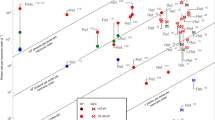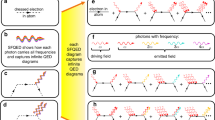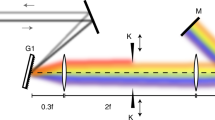Abstract
Many atomic and molecular systems of fundamental interest possess resonance frequencies in the extreme ultraviolet (XUV) where laser technology is limited and radiation sources have traditionally lacked long-term phase coherence. Recent breakthroughs in XUV frequency comb technology have demonstrated spectroscopy with unprecedented resolution at the megahertz level, but even higher resolutions are desired for future applications in precision measurement. By characterizing heterodyne beats between two XUV comb sources, we demonstrate the capability for sub-hertz spectral resolution. This corresponds to coherence times >1 s at photon energies up to 20 eV, more than six orders of magnitude longer than previously reported. This work establishes the ability of creating highly phase-stable radiation in the XUV with performance rivalling that of visible light. Furthermore, by direct sampling of the phase of the XUV light originating from high-harmonic generation, we demonstrate precise measurements of attosecond strong-field physics.
This is a preview of subscription content, access via your institution
Access options
Subscribe to this journal
Receive 12 print issues and online access
$209.00 per year
only $17.42 per issue
Buy this article
- Purchase on Springer Link
- Instant access to full article PDF
Prices may be subject to local taxes which are calculated during checkout




Similar content being viewed by others
References
Udem, Th. et al. Optical frequency metrology. Nature 416, 233–237 (2002).
Bloom, B. J. et al. An optical lattice clock with accuracy and stability at the 10−18 level. Nature 506, 71–75 (2014).
Kessler, T. et al. A sub-40-mHz-linewidth laser based on a Silicon single-crystal optical cavity. Nature Photon. 6, 687–692 (2012).
Bishof, M. et al. Optical spectrum analyzer at the atomic quantum projection noise limit. Phys. Rev. Lett. 111, 093604 (2013).
Cundiff, S. & Ye, J. Femtosecond optical frequency combs. Rev. Mod. Phys. 75, 325–342 (2003).
Attwood, D. T. Soft X-rays and Extreme Ultraviolet Radiation (Cambridge Univ. Press, 2007).
Berengut, J. C. et al. Electron–hole transitions in multiply charged ions for precision laser spectroscopy and searching for variations in α. Phys. Rev. Lett. 106, 210802 (2011).
Eyler, E. E. et al. Prospects for precision measurements of atomic helium using direct frequency comb spectroscopy. Eur. Phys. J. D 48, 43–55 (2007).
Campbell, C. J. et al. Single-ion nuclear clock for metrology at the 19th decimal place. Phys. Rev. Lett. 108, 120802 (2012).
Herrmann, M. et al. Feasibility of coherent XUV spectroscopy on the 1S–2S transition in singly ionized helium. Phys. Rev. A 79, 052505 (2009).
Ackermann, W. et al. Operation of a free-electron laser from the extreme ultraviolet to the water window. Nature Photon. 1, 336–342 (2007).
Young, L. et al. Femtosecond electronic response of atoms to ultra-intense X-rays. Nature 466, 56–61 (2010).
Emma, P. et al. First lasing and operation of an Ångstrom-wavelength free-electron laser. Nature Photon. 4, 641–647 (2010).
Suckewer, S. & Skinner, C. Soft X-ray lasers and their applications. Science 247, 1553–1557 (1990).
Bellini, M. et al. Temporal coherence of ultrashort high-order harmonic pulses. Phys. Rev. Lett. 81, 297–300 (1989).
Cingöz, A. et al. Direct frequency comb spectroscopy in the extreme ultraviolet. Nature 482, 68–71 (2012).
Yost, D. C. et al. Power optimization of XUV frequency combs for spectroscopy applications. Opt. Express 19, 23483–23493 (2011).
Kandula, D. Z. et al. Extreme ultraviolet frequency comb metrology. Phys. Rev. Lett. 105, 063001 (2010).
Morgenweg, J. et al. Ramsey-comb spectroscopy with intense ultrashort laser pulses. Nature Phys. 10, 30–33 (2013).
Jones, R. J. et al. Phase-coherent frequency combs in the vacuum ultraviolet via high-harmonic generation inside a femtosecond enhancement cavity. Phys. Rev. Lett. 94, 193201 (2005).
Gohle, C. et al. A frequency comb in the extreme ultraviolet. Nature 436, 234–237 (2005).
Mills, A. et al. XUV frequency combs via femtosecond enhancement cavities. J. Phys. B. 45, 142001 (2012).
Jones, R. J. & Ye, J. Femtosecond pulse amplification by coherent addition in a passive optical cavity. Opt. Lett. 27, 1848–1850 (2002).
Ruehl, A. et al. 80 W, 120 fs Yb-fiber frequency comb. Opt. Lett. 35, 3015–3017 (2010).
Allison, T. K. et al. Extreme nonlinear optics in a femtosecond enhancement cavity. Phys. Rev. Lett. 107, 193903 (2011).
Carlson, D. R. et al. Intracavity ionization and pulse formation in femtosecond enhancement cavities. Opt. Lett. 36, 2991–2993 (2011).
Vidal-Dasilva, M. et al. Electron-beam deposited boron coatings for the extreme ultraviolet. Appl. Opt. 47, 2926–2930 (2008).
Walls, F. L. & Demarchi, A. RF spectrum of a signal after frequency multiplication; measurement and comparison with a simple calculation. IEEE Trans. Instrum. Meas. 24, 210–217 (1975).
Hall, J. L. in Proceedings of the International School of Physics—Enrico Fermi (eds Arimondo, E., Phillips, W. D. & Strumia, F.) 671–702 (North-Holland, 1992).
Telle, H. R. in Frequency Control of Semiconductor Lasers (eds. Ohtsu, M.) 137–167 (Wiley, 1996).
Schibli, T. R. et al. Optical frequency comb with sub-millihertz linewidth and more than 10 W average power. Nature Photon. 2, 355–359 (2008).
Yost, D. C. et al. Vacuum-ultraviolet frequency combs from below-threshold harmonics. Nature Phys. 5, 815–820 (2009).
Lewenstein, M. et al. Phase of the atomic polarization in high-order harmonic generation. Phys. Rev. A 52, 4747–4754 (1995).
Zaïr, A. et al. Quantum path interferences in high-order harmonic generation. Phys. Rev. Lett. 100, 143902 (2008).
Corsi, C. et al. Direct interferometric measurement of the atomic dipole phase in high-order harmonic generation. Phys. Rev. Lett. 97, 023901 (2006).
Mairesse, Y. et al. Attosecond synchronization of high-harmonic soft X-rays. Science 302, 1540–1543 (2003).
Sansone, G. et al. Measurement of harmonic phase differences by interference of attosecond light pulses. Phys. Rev. Lett. 94, 193903 (2005).
Chang, Z. Fundamentals of Attosecond Optics 1st edn (CRC Press, 2011).
Hostetter, J. et al. Semiclassical approaches to below-threshold harmonics. Phys. Rev. A 82, 23401 (2010).
Krausz, F. & Ivanov, M. Attosecond physics. Rev. Mod. Phys. 81, 163–234 (2009).
Agåker, M. et al. Novel instruments for ultra-soft X-ray emission spectroscopy. Nucl. Instrum. Meth. A 601, 213–219 (2009).
Keilmann, F. et al. Time-domain mid-infrared frequency-comb spectrometer. Opt. Lett. 29, 1542–1544 (2004).
Hinnen, P. et al. XUV-laser spectroscopy of HD at 92–98 nm. Phys. Rev. A 52, 4425–4433 (1995).
Shafir, D. et al. Resolving the time when an electron exits a tunneling barrier. Nature 485, 343–346 (2013).
Itatani, J. et al. Tomographic imaging of molecular orbitals. Nature 432, 867–871 (2004).
Moll, K. D. et al. Output coupling methods for cavity-based high-harmonic generation. Opt. Express 14, 8189–8197 (2006).
Pupeza, I. et al. Compact high-repetition-rate source of coherent 100 eV radiation. Nature Photon. 7, 608–612 (2013).
Yost, D. C. et al. Efficient output coupling of intracavity high-harmonic generation. Opt. Lett. 33, 1099–1101 (2008).
Lee, J. et al. Optimizing intracavity high harmonic generation for XUV fs frequency combs. Opt. Express 19, 23315–23326 (2011).
Carstens, H. et al. Megawatt-scale average-power ultrashort pulses in an enhancement cavity. Opt. Lett. 39, 2595–2598 (2014).
Acknowledgements
The authors acknowledge technical contributions and collaboration from A. Ruehl, I. Hartl and M. E. Fermann. This work was supported by National Institute of Standards and Technology, Air Force Office of Scientific Research and the National Science Foundation Physics Frontier Center at JILA.
Author information
Authors and Affiliations
Contributions
C.B., T.K.A., A.C., D.C.Y. and J.Y. contributed to the design and planning of the experiment. C.B., L.H. and F.L. acquired the data. C.B., T.K.A., L.H., F.L. and J.Y. analysed the data. All authors discussed the results and contributed to the writing of the final manuscript.
Corresponding authors
Ethics declarations
Competing interests
The authors declare no competing financial interests.
Rights and permissions
About this article
Cite this article
Benko, C., Allison, T., Cingöz, A. et al. Extreme ultraviolet radiation with coherence time greater than 1 s. Nature Photon 8, 530–536 (2014). https://doi.org/10.1038/nphoton.2014.132
Received:
Accepted:
Published:
Issue Date:
DOI: https://doi.org/10.1038/nphoton.2014.132
This article is cited by
-
Resonant X-ray excitation of the nuclear clock isomer 45Sc
Nature (2023)
-
Extreme-ultraviolet frequency combs for precision metrology and attosecond science
Nature Photonics (2021)
-
Temporal solitons in free-space femtosecond enhancement cavities
Nature Photonics (2019)
-
Interferometry of dipole phase in high harmonics from solids
Nature Photonics (2019)
-
Ultimate waveform reproducibility of extreme-ultraviolet pulses by high-harmonic generation in quartz
Nature Photonics (2018)



